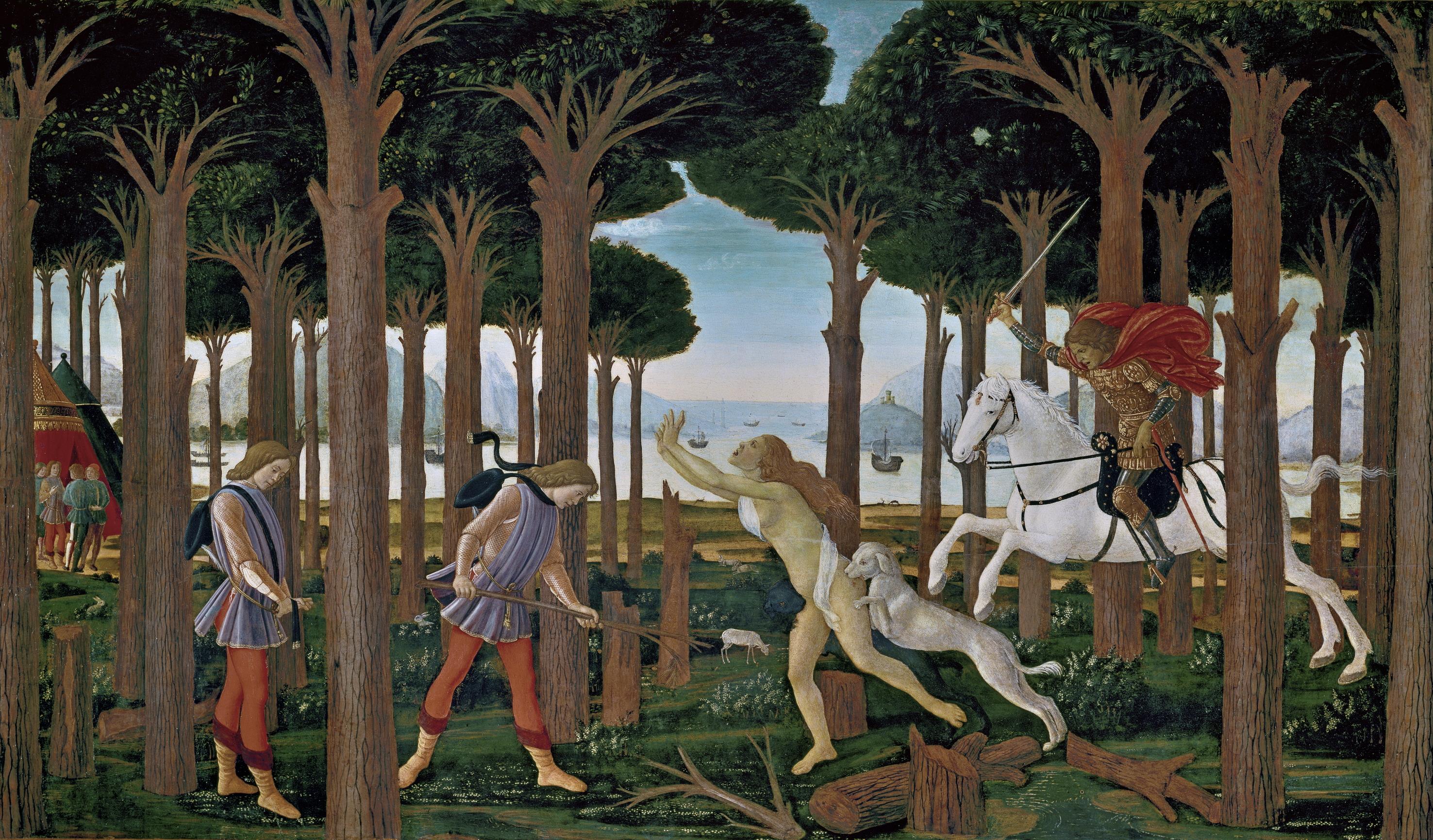The Story of Nastagio Degli Onesti, part one on:
[Wikipedia]
[Google]
[Amazon]
 ''The Story of Nastagio Degli Onesti, part one'' is a painting in tempera on wood by
''The Story of Nastagio Degli Onesti, part one'' is a painting in tempera on wood by
Museo Nacional del Prado: On-line gallery
{{DEFAULTSORT:Story of Nastagio Degli Onesti, part one, The Paintings by Sandro Botticelli Paintings in the Museo del Prado by Italian artists 1483 paintings Dogs in art Horses in art Ships in art Rabbits and hares in art Adaptations of works by Giovanni Boccaccio
 ''The Story of Nastagio Degli Onesti, part one'' is a painting in tempera on wood by
''The Story of Nastagio Degli Onesti, part one'' is a painting in tempera on wood by Sandro Botticelli
Alessandro di Mariano di Vanni Filipepi ( – May 17, 1510), known as Sandro Botticelli (, ), was an Italian Renaissance painting, Italian painter of the Early Renaissance. Botticelli's posthumous reputation suffered until the late 19th cent ...
, dated 1483. It measures 83 x 138 cm and is in the Museo del Prado in Madrid.
History
The picture is one of a series of four, possibly commissioned byLorenzo the Magnificent
Lorenzo di Piero de' Medici (; 1 January 1449 – 8 April 1492) was an Italian statesman, banker, ''de facto'' ruler of the Florentine Republic and the most powerful and enthusiastic patron of Renaissance culture in Italy. Also known as Lorenzo ...
in 1483 to donate to Giannozzo Pucci on the occasion of his wedding to Lucrezia Bini that year. The four were held in the Palazzo Pucci in Florence
Florence ( ; it, Firenze ) is a city in Central Italy and the capital city of the Tuscany Regions of Italy, region. It is the most populated city in Tuscany, with 383,083 inhabitants in 2016, and over 1,520,000 in its metropolitan area.Bilan ...
until 1868, when they were sold. The first three are now in the Prado, and the last one is now in original location after having spent some time in the Watney Collection in Charlbury
Charlbury () is a town and civil parish in the Evenlode valley, about north of Witney in the West Oxfordshire district of Oxfordshire, England. It is on the edge of Wychwood Forest and the Cotswolds. The 2011 Census recorded the parish's po ...
, Oxfordshire, England.
Description and style
The story of Nastagio degli Onesti, a nobleman ofRavenna
Ravenna ( , , also ; rgn, Ravèna) is the capital city of the Province of Ravenna, in the Emilia-Romagna region of Northern Italy. It was the capital city of the Western Roman Empire from 408 until its collapse in 476. It then served as the ca ...
, is the eighth tale of the fifth day in ''The Decameron
''The Decameron'' (; it, label= Italian, Decameron or ''Decamerone'' ), subtitled ''Prince Galehaut'' (Old it, Prencipe Galeotto, links=no ) and sometimes nicknamed ''l'Umana commedia'' ("the Human comedy", as it was Boccaccio that dubbed Da ...
'' by Giovanni Boccaccio. This theme was chosen for its happy ending to a love affair, in which the daughter of Paolo Traversari The Traversari (or ''domus Traversariorum'', according to medieval chroniclers) are a noble Italian family. The dynasty's history was mostly connected to Ravenna, which it ruled between the 12th and 13th centuries. St. Romuald was the son of Duke ...
, who rejects Nastagio's courting, changes her mind after witnessing the infernal punishment of another woman guilty of the same sin of ingratitude towards her lover.
The first episode of the story is set in a pine wood around Ravenna, the city where the story takes place. Nastagio has left the city, disappointed by his unreturned affection, and wanders alone and sorrowful. He is surprised by the sudden appearance of a woman being chased by a knight and his dogs, which seize her in their teeth in spite of Nastagio's attempts to defend her.
On the left in the painting are some tents, in which Nastagio (in the red hose) is seen being advised by his friends to leave town for a while. Then Nastagio is shown in close-up, roaming the forest. He appears again nearby with a stick, seeking to drive away the dogs that are trying to bite a half-naked woman, chased by a dashing knight with a sword and golden armour.
The scene has a strong narrative character, showing successive scenes within one picture and requiring three representations of Nastagio, a typically late medieval procedure. The tall, upright trunks of the trees combine with the horizontal seascape in the background to form a kind of grid, giving a remarkable effect of depth. The drama combines with the formal elegance of the slender figures and the graceful gestures of people and animals to achieve a magical suspension between fable and reality. Although the conception of the four pictures is due to Botticelli, the execution was entrusted in part to his assistants, in particular Bartolomeo di Giovanni
Bartolomeo di Giovanni di Domenico (1458? – 1501) was an Italian Renaissance painter active in Florence. His works were first identified by the art historian Bernard Berenson, who did not know the painter's real name so called him the "Alunn ...
for the first three pictures and Jacopo da Sellaio for the fourth.
See also
*List of works by Sandro Botticelli
The following is a list of panel paintings, works on canvas and frescoes by the Italian painter Sandro Botticelli.Barbara Deimling. ''Botticelli.'' Taschen. Cologne 2007. The few surviving drawings are excluded. It is not indicated if some works m ...
Further reading
* *References
External links
Museo Nacional del Prado: On-line gallery
{{DEFAULTSORT:Story of Nastagio Degli Onesti, part one, The Paintings by Sandro Botticelli Paintings in the Museo del Prado by Italian artists 1483 paintings Dogs in art Horses in art Ships in art Rabbits and hares in art Adaptations of works by Giovanni Boccaccio